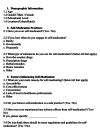Patterns and Prevalence of Self-Medication in Saudi Arabia: Insights From a Nationwide Survey
- PMID: 38283451
- PMCID: PMC10822194
- DOI: 10.7759/cureus.51281
Patterns and Prevalence of Self-Medication in Saudi Arabia: Insights From a Nationwide Survey
Abstract
Self-medication, the unsupervised use of drugs, is a common global behavior with potential adverse health outcomes. This study explores the prevalence and patterns of self-medication in Saudi Arabia, focusing on factors such as drug availability, economic constraints, and public trust in healthcare systems. Particular emphasis is placed on self-medication with antibiotics and prescription drugs due to their significant public health risks. Our comprehensive, quantitative, cross-sectional study surveyed 1,671 individuals across Saudi Arabia's diverse regions. We found that 75.5% of respondents engaged in self-medication, primarily on an occasional basis. While 59.8% of participants perceived self-medication as safe, 17.5% reported experiencing adverse effects. Respondents strongly advocated for increased regulatory measures (87.7%) and a pressing need for enhanced public education (92.6%) to address the associated risks. The study highlights the widespread practice of self-medication in Saudi Arabia, influenced by various factors, and underscores the need for targeted health policies and educational campaigns to mitigate these risks.
Keywords: adverse drug reactions; drug use patterns; health education; public health; self-medication.
Copyright © 2023, Alhur et al.
Conflict of interest statement
The authors have declared that no competing interests exist.
Figures
Similar articles
-
Self-medication with antibiotics in Saudi Arabia.Saudi Pharm J. 2018 Jul;26(5):719-724. doi: 10.1016/j.jsps.2018.02.018. Epub 2018 Feb 6. Saudi Pharm J. 2018. PMID: 29991916 Free PMC article.
-
An exploration of factors influencing the selection of generic and innovator medicines in Saudi Arabia using an observational cross-sectional study.Saudi Pharm J. 2024 Apr;32(4):102021. doi: 10.1016/j.jsps.2024.102021. Epub 2024 Mar 5. Saudi Pharm J. 2024. PMID: 38497088 Free PMC article.
-
Assessment of self-medication practice and the potential to use a mobile app to ensure safe and effective self-medication among the public in Saudi Arabia.Saudi Pharm J. 2022 Jul;30(7):927-933. doi: 10.1016/j.jsps.2022.05.010. Epub 2022 May 30. Saudi Pharm J. 2022. PMID: 35903533 Free PMC article.
-
Exploring the Landscape of Adult Acute Poisoning in Saudi Arabia: A Comprehensive Narrative Review.Cureus. 2024 Aug 14;16(8):e66842. doi: 10.7759/cureus.66842. eCollection 2024 Aug. Cureus. 2024. PMID: 39280539 Free PMC article. Review.
-
Saudi Arabia's Middle East respiratory syndrome Coronavirus (MERS-CoV) outbreak: consequences, reactions, and takeaways.Ann Med Surg (Lond). 2024 Jul 1;86(8):4668-4674. doi: 10.1097/MS9.0000000000002336. eCollection 2024 Aug. Ann Med Surg (Lond). 2024. PMID: 39118758 Free PMC article. Review.
Cited by
-
Self-medication among university students in Guangdong province, China: a cross-sectional study using the KAP model.Front Public Health. 2025 Jul 14;13:1601731. doi: 10.3389/fpubh.2025.1601731. eCollection 2025. Front Public Health. 2025. PMID: 40726944 Free PMC article.
-
Key modifiable risk factors for self-medication among university students: An observational study.Explor Res Clin Soc Pharm. 2024 Jul 29;15:100483. doi: 10.1016/j.rcsop.2024.100483. eCollection 2024 Sep. Explor Res Clin Soc Pharm. 2024. PMID: 39188585 Free PMC article.
-
Measuring Vitamin Literacy and Information-Seeking Behavior.Cureus. 2024 May 20;16(5):e60704. doi: 10.7759/cureus.60704. eCollection 2024 May. Cureus. 2024. PMID: 38903291 Free PMC article.
-
A Study of Awareness, Knowledge, Attitudes, and Practices Regarding Antibiotic Resistance.Cureus. 2024 Jun 21;16(6):e62854. doi: 10.7759/cureus.62854. eCollection 2024 Jun. Cureus. 2024. PMID: 39036208 Free PMC article.
References
-
- World Health Organization. Self-Care Interventions for Health. [ Dec; 2023 ];Zheng Y, Liu J, Tang PK, Hu H, Ung CO. https://www.who.int/health-topics/self-care. Front Public Health. 2023 11:1184882. - PubMed
-
- Risks of self-medication practices. Ruiz ME. Curr Drug Saf. 2010;5:315–323. - PubMed
-
- Prevalence and pattern of self-medication practices in urban area of southern Rajasthan. Jain M, Prakash R, Bapna D, Jain R. https://njcmindia.com/index.php/file/article/view/1245 Nat J Commun Med. 2015;6:474–477.
-
- Self-medication amongst university students of Karachi: prevalence, knowledge and attitudes. Zafar S, Syed R, Waqar S, et al. https://ecommons.aku.edu/pakistan_fhs_mc_chs_chs/29. J Pak Med Assoc. 2008;58:214–217. - PubMed
LinkOut - more resources
Full Text Sources





